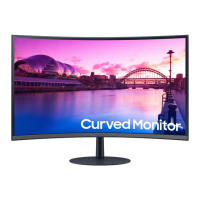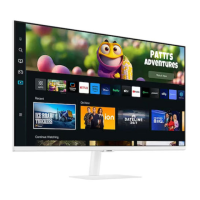Do you have a question about the Samsung S27C390EAE and is the answer not in the manual?
General safety guidelines and warnings for product usage.
Precautions related to power cords, plugs, and electrical hazards.
Instructions and precautions for physically installing the product.
Guidelines and warnings for using the product safely and effectively.
Step-by-step instructions for cleaning the product's exterior and panel.
Recommendations for maintaining a proper and healthy posture while using the product.
Detailed steps for assembling and attaching the product stand.
Instructions on how to safely detach the product's stand.
Important safety measures to follow when relocating the product.
Guidelines on maintaining adequate space around the product for ventilation.
How to adjust the monitor's tilt angle for optimal viewing.
Steps for securing the product using an anti-theft locking device.
Explanation of the product's control buttons and their functions.
Guide to accessing and using shortcut functions via the control panel.
Important steps to follow before connecting the product to a source device.
Description and function of all available ports on the product.
Methods for connecting the monitor to a personal computer.
Instructions for connecting the product using an HDMI cable.
Instructions for connecting the product using an HDMI-DVI cable.
Instructions for connecting the product using a DisplayPort cable.
How to connect headphones or earphones for audio output.
Steps to connect the power cable and turn the product on.
Tips and methods for neatly organizing connected cables.
Guide on how to set the optimal screen resolution for the product.
Options for adjusting picture quality and modes like Custom, Cinema.
How to adjust the general brightness of the picture.
How to adjust the contrast between objects and background.
How to adjust the clarity of object outlines.
Adjusting color tone, gamma, and saturation for optimal viewing.
How to adjust image quality using black level settings in HDMI mode.
Setting for eye relaxation and reduced eye fatigue.
Optimizing screen settings for an enhanced gaming experience.
Accelerating panel response rate for vivid video and gaming.
Changing the picture size to Auto/Wide or 4:3/16:9/Screen Fit.
Adjusting the screen's horizontal and vertical position.
Customizing menu transparency, position, language, and display time.
Configuration for FreeSync, Sound, and Eco Saving Plus features.
Automatically adjusts brightness for optimal screen contrast.
Setting the auto power-off timer for the product.
Setting the eco timer for automatic power-off to save energy.
Switching between PC and AV modes, useful for movie viewing.
Selecting the DisplayPort version for optimal compatibility.
Automatic switching to the newly connected device when no signal is present.
Controlling the response rate of buttons when pressed.
Enabling or disabling the power LED indicator on the product.
Configuring a custom key for direct access to selected functions.
Performing a test to diagnose potential monitor picture problems.
Instructions for updating the product's software using a USB device.
Viewing current software and hardware information.
Restoring all product settings to their default factory values.
Guide to installing and using the Easy Setting Box software.
Potential problems and environmental factors affecting Easy Setting Box installation.
Minimum OS and hardware requirements for Easy Setting Box and drivers.
Instructions for downloading and installing product drivers for optimal performance.
Steps to take before contacting Samsung Customer Service for assistance.
Using self-diagnosis to check for problems with the product screen.
Verifying supported resolution and frequency settings for proper display.
Troubleshooting common issues like popping sounds and installation problems.
Troubleshooting issues such as no image, distorted colors, blurry text, and choppy video.
Troubleshooting no sound, low volume, or sound sync problems.
Addressing issues related to beeping sounds during PC booting.
Answers to common questions about changing frequency, resolution, and power saving.
Overview of model name, size, display area, power, and signal connectors.
Information on the product's Plug-and-Play installation and compatibility.
Details about pixel variations and their impact on product performance.
Table listing supported resolutions, frequencies, and sync polarities.
Conditions under which service fees may be charged, even within warranty.
Situations not considered product defects, which may incur service charges.
Product damage resulting from mishandling, incorrect use, or unauthorized repair.
Additional scenarios that may lead to service fees, like natural disasters.
Explanation of FreeSync technology, its benefits, and supported graphics cards.
General safety guidelines and warnings for product usage.
Precautions related to power cords, plugs, and electrical hazards.
Instructions and precautions for physically installing the product.
Guidelines and warnings for using the product safely and effectively.
Step-by-step instructions for cleaning the product's exterior and panel.
Recommendations for maintaining a proper and healthy posture while using the product.
Detailed steps for assembling and attaching the product stand.
Instructions on how to safely detach the product's stand.
Important safety measures to follow when relocating the product.
Guidelines on maintaining adequate space around the product for ventilation.
How to adjust the monitor's tilt angle for optimal viewing.
Steps for securing the product using an anti-theft locking device.
Explanation of the product's control buttons and their functions.
Guide to accessing and using shortcut functions via the control panel.
Important steps to follow before connecting the product to a source device.
Description and function of all available ports on the product.
Methods for connecting the monitor to a personal computer.
Instructions for connecting the product using an HDMI cable.
Instructions for connecting the product using an HDMI-DVI cable.
Instructions for connecting the product using a DisplayPort cable.
How to connect headphones or earphones for audio output.
Steps to connect the power cable and turn the product on.
Tips and methods for neatly organizing connected cables.
Guide on how to set the optimal screen resolution for the product.
Options for adjusting picture quality and modes like Custom, Cinema.
How to adjust the general brightness of the picture.
How to adjust the contrast between objects and background.
How to adjust the clarity of object outlines.
Adjusting color tone, gamma, and saturation for optimal viewing.
How to adjust image quality using black level settings in HDMI mode.
Setting for eye relaxation and reduced eye fatigue.
Optimizing screen settings for an enhanced gaming experience.
Accelerating panel response rate for vivid video and gaming.
Changing the picture size to Auto/Wide or 4:3/16:9/Screen Fit.
Adjusting the screen's horizontal and vertical position.
Customizing menu transparency, position, language, and display time.
Configuration for FreeSync, Sound, and Eco Saving Plus features.
Automatically adjusts brightness for optimal screen contrast.
Setting the auto power-off timer for the product.
Setting the eco timer for automatic power-off to save energy.
Switching between PC and AV modes, useful for movie viewing.
Selecting the DisplayPort version for optimal compatibility.
Automatic switching to the newly connected device when no signal is present.
Controlling the response rate of buttons when pressed.
Enabling or disabling the power LED indicator on the product.
Configuring a custom key for direct access to selected functions.
Performing a test to diagnose potential monitor picture problems.
Instructions for updating the product's software using a USB device.
Viewing current software and hardware information.
Restoring all product settings to their default factory values.
Guide to installing and using the Easy Setting Box software.
Potential problems and environmental factors affecting Easy Setting Box installation.
Minimum OS and hardware requirements for Easy Setting Box and drivers.
Instructions for downloading and installing product drivers for optimal performance.
Steps to take before contacting Samsung Customer Service for assistance.
Using self-diagnosis to check for problems with the product screen.
Verifying supported resolution and frequency settings for proper display.
Troubleshooting common issues like popping sounds and installation problems.
Troubleshooting issues such as no image, distorted colors, blurry text, and choppy video.
Troubleshooting no sound, low volume, or sound sync problems.
Addressing issues related to beeping sounds during PC booting.
Answers to common questions about changing frequency, resolution, and power saving.
Overview of model name, size, display area, power, and signal connectors.
Information on the product's Plug-and-Play installation and compatibility.
Details about pixel variations and their impact on product performance.
Table listing supported resolutions, frequencies, and sync polarities.
Conditions under which service fees may be charged, even within warranty.
Situations not considered product defects, which may incur service charges.
Product damage resulting from mishandling, incorrect use, or unauthorized repair.
Additional scenarios that may lead to service fees, like natural disasters.
Explanation of FreeSync technology, its benefits, and supported graphics cards.
| Screen Size | 27 inches |
|---|---|
| Resolution | 1920 x 1080 |
| Refresh Rate | 60 Hz |
| Brightness | 250 cd/m² |
| Contrast Ratio | 1000:1 |
| Response Time | 5 ms |
| Aspect Ratio | 16:9 |
| Viewing Angle | 178° (H) / 178° (V) |
| Weight | 4.8 kg |
| Ports | HDMI |
| Power Consumption | 25 W |












